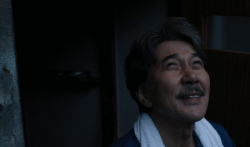A pair of inviting hands extends from a body, perched above a disordered sea of line and color. Close by, a man falls backwards, plunging downwards towards certain demise.
The painting’s title, “Warm Welcome,” is both appropriate and ironic. The hands and the man, coupled with the chaotic, cool-hued brushstrokes and zig-zags of neon paint, convey distrust in the comfort the arms offer. To today’s American student, the arms could represent entering adulthood or leaving home. To painter Inge H. Schmidt, the artist behind “Warm Welcome,” it was basic freedom of expression.
Schmidt is one of 10 artists featured in a new exhibition by the Breakthrough Art Organization, a nonprofit founded in 2009 by Jeff Thines. Thines moved to Germany in the early 1990s, and during his time there he met numerous artists who had spent their formative years behind the Iron Curtain.
“[These artists] did not want to conform to the dominant socialist ideology, and had to take great risks to paint or sculpt or take photographs of what they wanted,” Thines said.
With this year marking the 20th anniversary of German unification, Thines started Breakthrough with partial funding from the German government and Georgetown’s Center for German and European Studies to illustrate what happens when artists are deprived of basic American freedoms. The exhibition is a five-city tour, which lands in D.C.’s Edison Place Gallery this September. For a week of each month-long installment, the artists visit the exhibit to discuss the themes of oppression and Cold War-era fear that characterize all the works in the show.


The collection’s seven painters, two photographers, and one sculptor each make a distinct contributions. Through a variety of perspectives, this exhibit forcefully illustrates life under the German Democratic Republic, both artistically and personally. Gerald Adam Hahn’s haunting photographs of working-class Germans embody physical and emotional exhaustion, while Hans Schieb’s sculpture “Creep” depicts a nude, bloodied, and freakish man with oversized hands and menacing teeth, marching with a German flag, to signify the inhuman nature of East Germany and its supporters.
Some pieces are more subtle. On first glance, painter Thomas Klingenstein’s “Buddha” has no references to freedom or communism. But when Klingenstien told his story in Nashville, he revealed the connection: his interest in Asian culture pegged him as an ideological enemy of the state and prohibited him from pursuing his curiosity.
“You [could] see the wonderment in people’s eyes, that the system was so pervasive,” Thines said of the discussion.
In a film on Breakthrough’s website, the artists discuss the experiences that both fostered and suppressed their artistic achievements.
“If I choose to be an artist, then I choose to live and think freely,” Schmidt says. It is a freedom that Americans are accustomed to, and whose value Breakthrough challenges its audience to consider more carefully.




